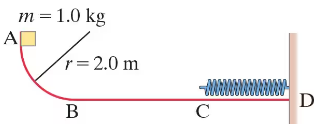A 62-kg trampoline artist jumps upward from the top of a platform with a vertical speed of 4.5 m/s. If the trampoline behaves like a spring of spring constant 5.8 x 104 N/m, how far does he depress it?
<IMAGE>

 Verified step by step guidance
Verified step by step guidance Verified video answer for a similar problem:
Verified video answer for a similar problem:



 6:24m
6:24mMaster Conservation Of Mechanical Energy with a bite sized video explanation from Patrick
Start learning